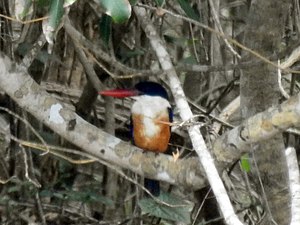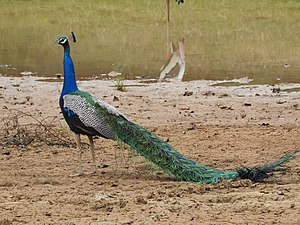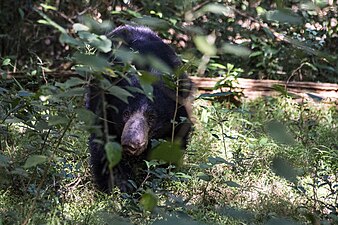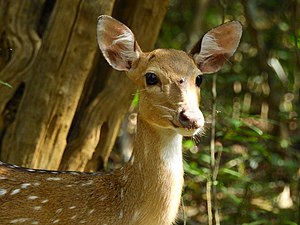Wilpattu National Park
A second, more extensive camera trap survey was conducted from May to September 2018 by Samarasinghe et al. (2022), covering a substantial area of the national park, approximately 660 km, and capturing a total of 133 individual leopards. This count comprised 116 independent leopards (aged over 2 years) and 17 cubs. Eight adult females were observed with 1–2 cubs during the study. Utilizing Bayesian spatial capture-recapture models, the population density of leopards in Wilpattu National Park was estimated to be 18 leopards per 100 km. The mean abundance (N) within the effectively sampled area was calculated to be 144 leopards. Notably, the national park maintains a healthy sex ratio of male to female leopards, estimated to be 1:2.03.
From December 1988 to 16 March 2003, the park was closed due to security concerns surrounding the Sri Lankan Civil War, before being reopened to visitors sixteen years later. Visitor access is currently limited to approximately 25% of the park, the remainder of which is dense forest or scrub. Popular visiting periods span between the months of February and October, although there are a number of private ecotourism groups that conduct safaris year-round.
History
The Mahavansa records that in 543 BC Prince Vijaya landed at Tambapanni now known as Kudrimalai Point (Horse Point), established the Sinhalese kingdom in Tambapanni and founded the Sinhala nation. In 1905 the area was designated a sanctuary and in 1938 it was upgraded to the National Park status.'
Kudrimalai, or Horse Point, was visited by a subject of Emperor Claudius in 47 AD, who was blown off course by the monsoon. The local king later sent his own envoys to Rome during the time of Pliny.
Climate

The annual Rainfall is about 1,000 mm (39 in) and the annual temperature is about 27.2 °C (81.0 °F). Inter-monsoonal rains in March and the northeast monsoon (December – February) are the main sources of rainfall.
Flora and fauna
There are many types of vegetation to be found in Wilpattu, including littoral vegetation, such as salt grass and low scrub monsoon forest with tall emergents, such as palu (Manilkara hexandra), and satin (Chloroxylon swietenia), milla (Vitex altissima), weera (Drypetes sepiaria), ebony (Diospyros ebenum) and wewarna (Alseodaphne semecapriflolia).
31 species of mammals have been identified within Wilpattu national park. Mammals that are identified as threatened species living within the Wilpattu National Park are the elephant (Elephas maximus maximus), sloth bear (Melursus ursinus inornatus), leopard (Panthera pardus kotiya) and water buffalo (Bubalus bubalis). sambar (Rusa unicolor unicolor), spotted deer (Axis axis ceylonensis), mongoose, mouse and shrew are more of Wilpattu's residents.
Birds
The painted stork, the open bill, little cormorant, Sri Lankan junglefowl (Gallus lafayetii) along with many species of owls, terns, gulls, eagles, kites buzzards are to be found at Wilpattu National Park. Wetland bird species that can be seen in Wilpattu are the garganey (Anas querquedula), pintail (Anas acuta), whistling teal (Dendrocygna javanica), spoonbill (Platalea leucorodia), black-headed ibis (Threskiornis malanocephalus), large white egret (Egretta alba modesta), cattle egret (Bubulcus ibis) and purple heron (Ardea purpurea).
Reptiles
The most common reptiles found in the park are the monitor lizard (Varanus bengalensis), mugger crocodile (Crocodylus palustris), common cobra (Naja naja), rat snake (Ptyas mucosus), Indian python (Python molurus), pond turtle (Melanonchelys trijuga) and the soft shelled turtle (Lissemys punctata) which are resident in the large permanent Villus.
Expansion of the boundary
The boundary of the Wilpattu national park originally enclosed the Puttalam District in the south and Anuradhapura District in the east. On October 10, 2012, the government published several gazettes (section 3 of the forest conservation ordinance, chapter 451) which effectively extended the park's boundary to include regions of the northern province. The expansion of the Wilpattu National Park boundary in 2012 is considered a significant obstacle for internally displaced people, particularly those affected by the Expulsion of Muslims from the Northern Province of Sri Lanka by the LTTE to return to their homeland.
Deforestation
After the end of the civil war, allegations had been made that parts of the reserve has been occupied to build houses by certain politicians in an attempt to create Muslim colonies in Wilpattu. The multiple civil societies and researchers put forth the notion that these were people who had been forcibly driven away by the LTTE in 1990 in accordance to their ethnic cleansing policy who had returned to their original villages. Notably, the park was extended to the current size in 1999 after the ethnic cleansing where the old villages were marked as part of the park as claimed by the people in this area. Aerial images taken in 2018 reputedly shows that a considerable portion of the forest has been opened up and a large number of small houses being built in the area.
Gallery
Photographs of animals taken within the national park.
Birds
Reptiles
Terrestrial animals
References
- ^ "Wilpattu Ramsar Wetland Cluster". Ramsar Sites Information Service. Retrieved 25 April 2018.
- ^ Kittle, A. M.; Watson, A. C.; Samaranayake, P. K. L. (May 2021). "Edge effects and distribution of prey forage resources influence how an apex predator utilizes Sri Lanka's largest protected area". Journal of Zoology. 314 (1): 31–42. doi:10.1111/jzo.12870. ISSN 0952-8369.
- ^ Samarasinghe, Dinal J. S.; Wikramanayake, Eric D.; Gopalaswamy, Arjun M.; Jayewardene, Rukshan; Kumara, Jehan; Fernando, Javana; Gunawardene, Kithsiri; Alexander, Justine Shanti; Braczkowski, Alexander (2022-09-01). "Evidence for a critical leopard conservation stronghold from a large protected landscape on the island of Sri Lanka". Global Ecology and Conservation. 37: e02173. doi:10.1016/j.gecco.2022.e02173. hdl:10072/423132. ISSN 2351-9894.
- ^ "Project Expedition". Project Expedition. Retrieved 2021-02-07.
- ^ "Separating The Issues Concerning Muslim Resettlement". Colombo Telegraph. 2015-06-01. Retrieved 2021-04-25.
- ^ "Survey Online Store". www.survey.gov.lk. Retrieved 2021-04-25.
- ^ "Future of the displaced in Musali South – Ilankai Tamil Sangam". sangam.org. Retrieved 2021-04-25.
- ^ BARRETTE, Cyrille (1977). "Some aspects of the behaviour of muntjacs in Wilpattu National Park". Mammalia. 41 (1): 1–34. doi:10.1515/mamm.1977.41.1.1. ISSN 0025-1461. S2CID 85200104.
- ^ H., Hasbullah, S. (2015). Denying the right to return : resettlement in Musali South and the Wilpattu controversy. Kandy Forum. ISBN 978-955-7902-00-5. OCLC 986423834.
{{cite book}}: CS1 maint: multiple names: authors list (link) - ^ "Muslims Caged In Musali". Colombo Telegraph. 2017-04-09. Retrieved 2021-04-26.
- ^ "Muslims Caged In Musali". Colombo Telegraph. 2017-04-09. Retrieved 2021-04-26.
- ^ "Wilpattu deforestation controversy". Retrieved 30 September 2018.
- ^ "The Controversy of Wilpattu – Ilankai Tamil Sangam".
- ^ Köpke, Sören (2021). "Contested Conservation, Ethnopolitics, and the State". Conservation & Society. 19 (1): 57–67. doi:10.4103/cs.cs_19_113. JSTOR 26979978. S2CID 232023641.
- ^ "The Wilpattu Controversy: Open Letter to the President". 31 March 2017.
- ^ "Wilpattu deforestation controversy". Retrieved 30 September 2018.
- ^ "New developments in deforestation of Wilpattu". YouTube. Archived from the original on 2021-12-21. Retrieved 30 September 2018.
External links
![]() Media related to Wilpattu National Park at Wikimedia Commons
Media related to Wilpattu National Park at Wikimedia Commons



























